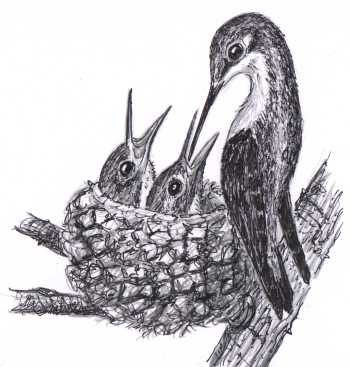
Dear Bird Folks:
I know you asked for no more hummingbird questions, but please answer this one for me. I have bet my great aunt a box of Cuban cigars on this question. Do hummingbirds have beaks that open and close like other birds or do they sip through a one-piece, straw-like beak that doesn’t open?
Rowdy, Orleans
First of all, Rowdy,
If you are going to ask a question like this, don’t use your real nickname. Try to be a little more ambiguous. How many “Rowdys” can there be in Orleans now that summer is over? You could be setting yourself up for ridicule. As you walk down the street, all of your friends will be pointing at you and chanting “Rowdy, Rowdy what a freak, doesn’t know much about hummingbird beaks.” Then there is the issue of tipping off the U.S. Customs Department and your Cuban cigar racket. I’m sure they read this column faithfully. And remember, betting is illegal. I’ll lay you 10-1 that the Massachusetts State Gaming Commission will be interested in your little gambling ring.
As for your hummingbird question, do you or your aunt really believe that a hummingbird’s beak is some kind of one-piece sucking straw? I think someone is smoking more than cigars. Or perhaps one of you has hummingbirds mixed up with an elephant and it’s trunk. Hummingbirds are birds, real birds, and they have everything that a robin or cardinal has, including feet, legs, wings and a beak that acts and works like any other bird’s beak.
Remember, much of a hummingbird’s diet is made up of insects. They obtain these insects by using their superior flying skills, along with their beak and tongue to snag insects out of the air, not by sucking bugs out of the sky. As for sipping nectar from flowers, their beak has little to do with it. It is the hummingbird’s extremely long tongue that does most of the work. A hummingbird’s tongue is split at the end with tiny hair-like fibers that help gather nectar from flowers.
Even though a hummingbird’s beak isn’t the key feature in gathering nectar, the beak is essential for grooming and preening. Feathers are birds’ only protection from the elements and it is critical that they keep neat and clean. Hummingbirds use their long beak to regularly groom their feathers. They grasp each feather with their beak and clean off all of the dirt, grime and parasites, while also adding protective oil to their feathers.
And let’s not forget the nest building chores, Rowdy. The hummer’s beak is the only tool that they have to build their nests. The female gathers the material and constructs the nest using nothing more than her beak. Also, without their beak being able to open, there would be no way for the mother to feed the baby birds. The adult bird shoves insects down the wide open gape of the hungry baby. With your tube beak idea, feeding the baby birds would be rather difficult, not to mention messy. A tube-to-tube connection would be impossible without a plumber, and who can get one of those to show up.
I don’t know who is going to win the bet, Rowdy, but the answer to your question is that hummingbirds most assuredly can open and close their beaks. Betting a box of Cuban cigars over a bird question may sound a little strange, but who am I to judge? I think that it’s cool that you have such a fun relationship with your great aunt. The only thing that I ever bet my great aunt was that she couldn’t eat a caramel apple with her false teeth. I won the bet, but I had to buy her a new set of teeth. That could have been expensive, but fortunately I got lucky at the Orleans swap shed.